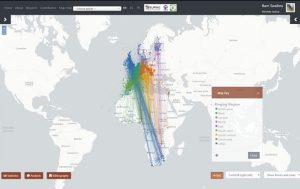Visualising how migratory animals connect continents, countries, sites and habitats are the result of an international scientific effort under the aegis of the Convention on the Conservation of Migratory Species of Wild Animals (CMS), in developing the first atlas of bird migration across three continents.

CMS, an environmental UN treaty, launched the Eurasian-African Bird Migration Atlas on Thursday, May 26, 2022, at the Museum of Migration on the Italian island of Ventotene, as the first part of a broader initiative to develop a global atlas of animal migration.
The interactive Atlas is an online platform where data on the movements in time and space of millions of birds are mapped and analysed in the Eurasian-African flyway. Researchers from 10 different institutions and data gathered by over 50 different organisations contributed to the Atlas, which was developed by CMS partners, the European Union for Bird Ringing (EURING) and the Max Planck Institute of Animal Behaviour.
A major accomplishment of the Eurasian-African Bird Migration Atlas is to have collated, analysed, and synthesised bird ringing data collected over more than 100 years on 300 species.
In addition, for over 100 of these species, the online mapping tool overlays movement patterns identified through bird ringing with tracks obtained through satellite transmitters, GPS-GSM tags or geo-locators. Together, they provide the most complete information available on the migration routes of these species.
An important visualisation tool for more effective implementation of conservation measures
For CMS, whose main goal is to conserve migratory species throughout their migratory range and migration itself as a biological phenomenon, a detailed understanding of the different migratory systems and patterns across the different groups of migratory species is important to design and implement conservation strategies and actions.
The new Atlas offers new insights into migration patterns at the species and population levels and into human-related issues affecting them across their migratory paths.
CMS Executive Secretary, Amy Fraenkel, said: “Knowledge of how animals move and migrate over time and space is crucial for improving our understanding and conservation efforts for migratory species. The Atlas will help decision-makers in planning networks of sites managed for conservation purposes.”
The information compiled in the Atlas is expected to offer an important contribution to CMS initiatives on the preservation of ecological connectivity – the unimpeded movement of species and the flow of natural processes that sustain life on Earth – and spatial planning in particular.
These relate for example to possible interactions between renewable energy infrastructure and animal migration, with a special emphasis on the risk of collision of migratory birds at wind farms. Maps of seasonal movements across geographical areas can help define strategies to minimise bird mortality risks caused by these infrastructures.
